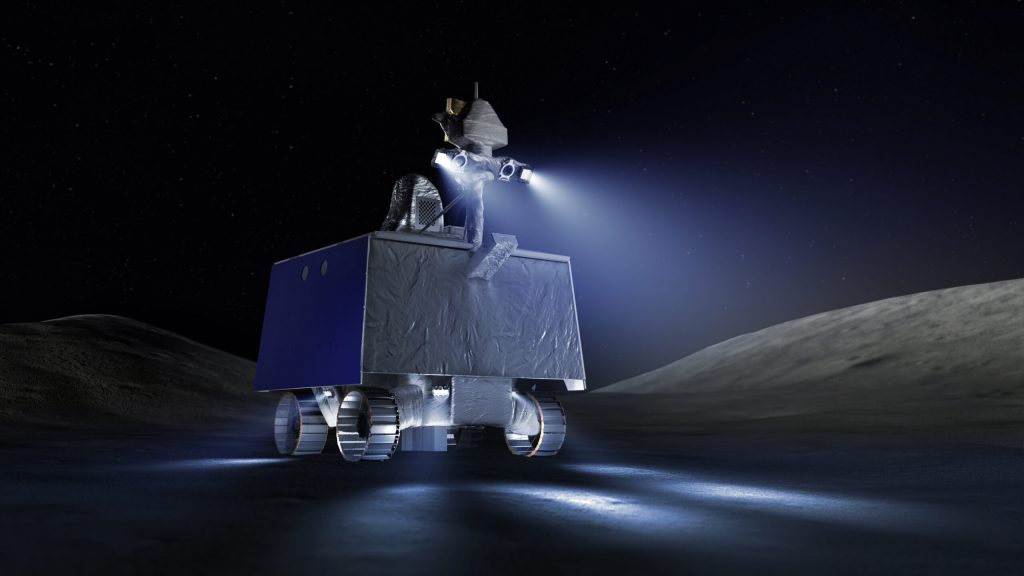BUSAN, South Korea — NASA has canceled a robotic lunar exploration mission to search for ice on the moon’s south pole, citing development delays and cost overruns.
NASA announced on July 17 that it was ending development of the Volatile Investigation Polar Rover (VIPER) mission. The rover, scheduled to be sent to the lunar south polar region on Astrobotic Technology’s commercial lander called Griffin, would explore the landscape, including areas in permanent shadow, to better understand the extent and shape of water ice there.
At a briefing announcing the cancellation, officials said VIPER’s costs had increased by more than 30 percent, necessitating the authorities’ consideration of canceling it. NASA approved VIPER for 2021 at a cost of $433.5 million.The latest estimate is $609.6 million, with launch expected in September 2025, said Joel Karns, associate administrator for exploration at NASA’s Science Mission Directorate.
“In this case, the remaining projected costs of VIPER would result in the cancellation or suspension of many other missions in our Commercial Lunar Payload Service Line,” said Nicky Fox, NASA’s assistant administrator for science, “so we’ve made the decision to abandon this particular mission.”
Kearns said VIPER has been hit by a series of supply chain issues dating back to the pandemic, which delayed the delivery of critical but unspecified parts. “We had multiple delays on some key parts,” Kearns said, adding that incremental delays made planning for the mission more difficult than one big delay.
This complicated the construction of the rover, which is about the size of a small car, being built from the inside out: “Many of the delayed parts were actually in the interior parts of VIPER, so when parts were delayed, it forced the VIPER team to slow assembly, which delayed integration and initial testing.”
While the spacecraft is complete, environmental testing has only just begun. Kearns said the revised cost and schedule assumes VIPER passes environmental testing without issue. “I will say that in general, spacecraft development system-level environmental testing uncovers issues that need to be fixed, which takes more time and costs more money.”
Canceling VIPER now would save NASA at least $84 million, he said, and that could increase if VIPER’s launch is delayed beyond November 2025 because of the nine to 12 months it would have to wait for proper lighting conditions to be restored at the polar landing site.
Kearns and Fox said much of the scientific research VIPER would have done will likely be done by other missions, including landers and orbiters, but the mobility VIPER would have offered may not be available until NASA’s lunar rover (a rover for the crewed Artemis missions, but capable of being remotely operated) is delivered later this century.
NASA plans to disassemble VIPER and reuse its instruments and other parts. But first, the space agency will consider proposals from U.S. companies and international partners to fly VIPER independently, at no cost to the government. Proposals must be submitted to NASA by August 1.
Griffin Mission Revision
Aside from its own development problems, VIPER has also faced delays to Griffin, the Astrobotic lander that will deliver the rover to the lunar surface under a $322 million task order for CLPS. NASA has said it doesn’t expect Griffin to be ready for the mission until September 2025 at the earliest.
With VIPER canceled, NASA will maintain the mission command for Griffin. The mission will be a technology demonstration, carrying a mass simulator instead of a rover to test Griffin’s ability to land large payloads.
Kearns said NASA considered flying a scientific payload instead, but the lander was designed to carry a rover and lacked the facilities and capabilities a payload would need, such as power and communications.
“If we were to ask Astrobotic to make such changes, it would further delay their schedule,” he said of potential modifications to accommodate the payload, “which would translate into additional costs for the government. And it would delay the demonstration of a successful Antarctic landing with the large Griffin lander, which we’re very interested in.”
Astrobotic is also free to fly its own commercial payloads, and Astrobotic Chief Executive Officer John Thornton said in an interview that the company is considering test flights of its own commercial payloads. LunaGrid Power Generation Services “We want to fly fast, but we also want to have a mission that has a bigger impact than just the lander itself,” he said of Griffin.
Griffin would still land on the moon’s south pole without VIPER, but it wouldn’t have to land in the same spot NASA chose for VIPER, he said — depending on the new payload the lander carries, it could choose to go to a safer landing site to reduce the mission’s risks.
Both Kearns and Thornton said NASA informed Astrobotic of the decision very recently, but declined to provide details. One industry source said NASA informed Astrobotic of the decision just a day before it was made public.
“It’s certainly been a year of turmoil and challenges for Astrobotic as a company,” he said, referring to the launch of the company’s first lunar lander, Peregrine, in January. A fuel leak occurred after launch and prevented the moon landing attempt.The cancellation of VIPER is “certainly another blow, but we’re open to it.”
Kearns noted that NASA believes Griffin can land safely on the moon with or without VIPER, and that the space agency is funding the company to conduct additional testing of the propulsion system: “We’re confident they can make this landing,” he said. “We wouldn’t be continuing to work with them if they weren’t.”
“I’m an eternal optimist, and if you’re in the space industry, this is just going to happen,” Thornton said. “I’m excited to see how we can change this.”


